
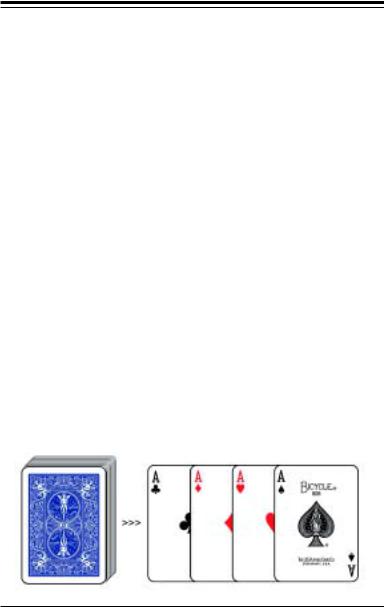
2. The Basic Calculations
Odds & Probabilities
Odds and Probabilities are simply two methods of expressing the relationship of Positives, Negatives and Total Possibilities. They represent the same basic information and each can be easily converted into the other.
Odds
Odds in poker are expressed as a ratio of the Negatives to the
Positives:
WILLNOTs : WILLs
With a well-shuffled deck of cards, what are the Odds that the first card from the deck will be one of the 4 Aces?
9

2. The Basic Calculations
Total Possibilities = 52 Cards in the Deck Positives/WILLs = 4 Aces in the Deck
Negatives/WILLNOTs = 48 Cards not Aces
To calculate odds or probability, you only need to know any 2 of 3 values: WILLs, WILLNOTs and Total Possibilities. There are 3 easy ways to find the third value:
Total Possible (52) – WILLs (4) = WILLNOTs (48) Total Possible (52) – WILLNOTs (48) = WILLs (4) WILLNOTs (48) + WILLs (4) = Total Possible (52)
In a deck of 52 cards (Total Possibilities) there are 4 cards (WILLs) that are Aces and 48 cards (WILLNOTs) that are not Aces.
The odds of drawing an Ace is the ratio of the cards that WILLNOT be Aces to the cards that WILL be Aces:
WILLNOTs : WILLs 48 : 4 Reduce
48 / 4 : 4 / 4
12 : 1
The odds against drawing an Ace are 12 to 1.
Probabilities
Probabilities are expressed as either a decimal ratio to 1 or as a percentage. Here is an easy-to-use formula to calculate either:
WILLs |
= Probability as decimal ratio to 1 |
Total Possibilities |
10

Odds & Probabilities
WILLs |
* 100 = Probability as % |
|
Total Possibilities |
||
|
Total Possibilities is the number of cards in the deck, 52.
The number of cards that WILL, is the number of Aces in the deck, 4.
The probability that the first card off a well-shuffled deck will be an Ace is
|
WILLs |
= Probability as decimal ratio to 1 |
|||||
|
Total |
|
Possibilities |
||||
|
|
|
|
|
4 |
= .0769 |
|
|
|
|
|
|
|||
|
|
|
|
52 |
|||
|
WILLs |
* 100 = Probability as % |
|||||
Total Possibilities |
|||||||
|
|
|
|||||
524 * 100 = 7.69%
Another way to calculate probabilities is to multiply the probability of the components. For example, the probability of finding a pair of Aces in the hole in Hold’em can be found by
WILLs |
= Probability as decimal ratio to 1 |
Total Possibilities |
With 6 possible pairs of Aces and 1,326 possible pairs, the probability of Aces is
6 = .0045249
1,326
11

2. The Basic Calculations
Another way to get the same answer is to multiply the probability that your first card in the hole will be an Ace by the probability that your second card in the hole will be an Ace:
524 * 513 = .0045249
Conversions
Because ALL odds and probability calculations begin with two of three basic values (Total Possibilities, WILLs and WILLNOTs), the conversion of odds to probability or vice versa is straightforward.
In the example above the odds are 12 : 1. Odds are an expression of WILLNOTs : WILLs.
To convert these odds to a probability expressed as a percentage:
WILLs |
|
* 100 = Probability as % |
|
Total Possibilities |
|||
|
|||
524 * 100 = 7.6923%
To re-convert this 7.6923% probability back to odds, you know that this probability, 7.6923%, represents the WILLs and that in any probability situation the Total Possibilities are 100%. Thus you have the WILLs and only need the WILLNOTs to express this probability as odds:
Total Possibilities = 100%
– WILLs = 7.6923%.
WILLNOTs = 92.3077%
12

Odds & Probabilities
WILLNOTs (92.3077) : WILLs (7.6923) 92.3077 : 7.6923
Reduce
92.3077 / 7.6923 : 7.6923 / 7.6923
12 : 1
To complete this circle of conversions, we will reconvert the 12 : 1 odds back to a probability expressed as a decimal ratio to 1.
To calculate the probability expressed as a decimal ratio to 1 you need to know the WILLs and the Total Possibilities. From odds of 12 : 1 we know that the WILLs are 1 and the
WILLNOTs are 12. WILLs(1) + WILLNOTs(12) = Total Possibilities(13). You now have the all numbers needed to calculate 12 : 1 as a decimal probability to 1.
WILLs |
= Probability as decimal ratio to 1 |
Total Possibilities |
131 = .076923
Quickie conversion finale: the conversion of the probability of .076923 back into odds is
Total Possibilities = 1
– WILLs = .076923
WILLNOTs = .923077
WILLNOTs (.923077) : WILLs (.076923)
.923077 : .076923 Reduce
.923077 / .076923 : .076923 / .076923
12 : 1
13

2. The Basic Calculations
Combinations, Permutations & Factorials
Whether it is called combinatorics or combinatorial math, it is a branch of discrete mathematics that for our purposes deals with the determination of the size of certain sets.
Most odds and probability calculations can be reduced to 2 basic steps:
1.Define the Sets — The calculation of any set of odds or probabilities involves the comparison of 2 of 3 sets: Total Possibilities, WILLs and WILLNOTs.
2.Compare the Sets — Odds in poker are an expression of the comparison of the number of WILLNOTs : WILLs. Probabilities are an expression of WILLs / Total Possibilities.
Formulae that calculate the populations of combinations, permutations or factorials are used to calculate the population of the WILL and WILLNOT sets.
Mathematicians express combinations as “C(52, 2),” in Practical Poker Math, we have used “Comb(52, 2).” Permutations are expressed as “P(52, 2)” and we have used “Perm(52, 2).” For factorials we have used the standard 52!.
Combinations
The mechanics of the math used to determine the enumeration of combinations is more easily demonstrated than explained.
Of the 3 (combinations, permutations and factorials) the
14
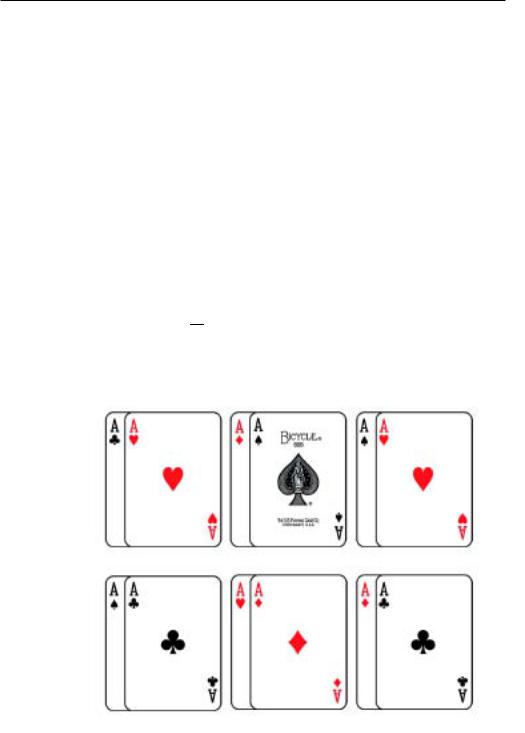
Combinations, Permutations & Factorials
most used calculation in poker is the determination of the size of certain combinations.
The calculation of a combination in the format of Comb(52, 2), will produce the number of different 2-card combinations
— starting hands — that are possible from a 52-card deck:
(52 * 51) = 1,326 (1 * 2)
To find the number of 3-card Flops possible from the 50 remaining unseen cards after you have been dealt your 2 hole cards in Hold’em, use Comb(50, 3):
(50 * 49 * 48) = 19,600 (1 * 2 * 3)
There are 6 different pairs or 2-card combinations of Aces that can be made from the 4 Aces in a 52-card deck:
15

2. The Basic Calculations
This can be calculated using Comb(4, 2):
(4 * 3) = 6 (1 * 2)
With 10 great picks for a weekend of sports betting, to find the number of 4-bet parlays — Comb(10, 4):
(10 * 9 * 8 * 7) = 210 (1 * 2 * 3 * 4)
There are basically two ways to calculate probabilities:
1.The comparison of sets
2.The mathematical comparison of probabilities.
The comparison of sets is more commonly used and is helpful when trying to determine the size of multiple sets.
The Lottery
We can use these same formulae to find the odds or probability of winning a state lottery. As an example, use a lottery where, to win, a player must correctly pick 5 numbers in the range of 1 through 47 and 1 correct “special” number from 1 through 27.
To find the number of possible 5-number combinations in 1 through 47 — Comb(47, 5):
(47 * 46 * 45 * 44 * 43) = 1,533,939 (1 * 2 * 3 * 4 * 5)
To find the total number of possible 6-number combinations in 1 through 27:
16
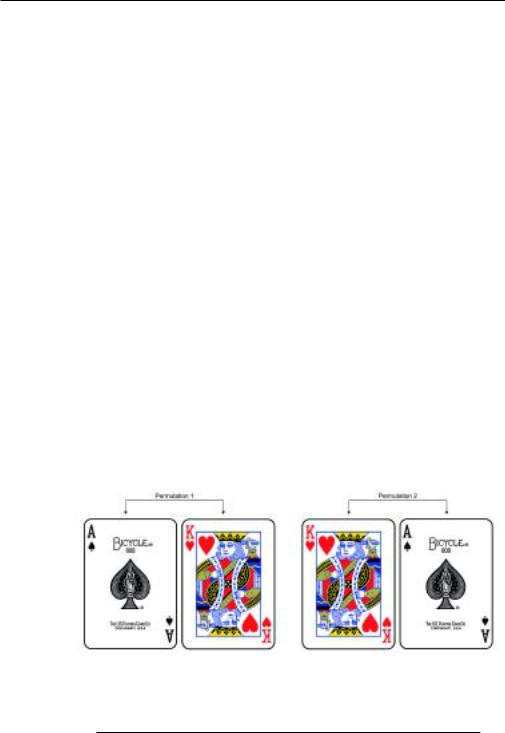
Combinations, Permutations & Factorials
1,533,939 * 27 = 41,416,353
41,416,352 combinations WILLNOT win the lottery and only 1 WILL.
WILLNOTs : WILLs 41,416,352 : 1
Assume that
1.yours was the only winning ticket
2.you took a cash-settlement for half the amount and
3you have to pay 1/3 of your win in taxes.
To have a positive expectation from the purchase of a $1.00 ticket, the lottery’s first prize would have to be on the order of $125,000,000.00.
Permutations
To demonstrate the difference between combinations and permutations, the two hands below are 2 different permutations of the same combination.
The number of 2-card permutations possible from a 52-card deck — Perm(52, 2) is:
17

2. The Basic Calculations
52 * 51 = 2,652
At the racetrack, with an 8-horse field, the number of possible trifecta tickets — Perm(8, 3) is:
8 * 7 * 6 = 336
Factorials
Factorials are seldom, if ever, used in poker and are mostly about orderings. A deck of 52 cards contains one combination and many permutations or orderings.
The factorial of 52 is expressed as 52! (sometimes called 52 bang). On a scientific calculator one would enter 52 and then press the n! key.
52! yields the number of possible deck sequences or orderings that can be created from one 52-card deck. The mechanics of the calculation 52! are
52 * 51 * 50 * 49 * 48 *… through * 4 * 3 * 2 * 1
When you enter 52! into a scientific calculator the result is 8.065817517 +e67 which (give or take a zero or two) is equal to:
8,065,817,517 plus 58 more zeros
This is the number of possible decks or orderings that may be created from a single deck of 52 cards.
18

Money Odds & Expectation
Money Odds & Expectation
The simplest explanation we have for the complex subject of money odds and expectation is
The Odds will tell you the Risk and
The Pot will tell the Reward
Put another way: if the money odds are greater than the overall odds of winning the pot, you have a positive expectation.
Pot Odds
Pot Odds are an expression of what the pot is offering on a particular round and doesn’t take into consideration any action that might come on future rounds.
Pot Odds reveal nothing about a player’s chances of winning a pot, but only indicate the money leverage he is being offered at that moment if he stays in the pot. Money odds are an expression of the ratio of the money in the pot, including previous bets and calls on this round, to the amount it will cost to stay in the hand.
With $600 in the pot plus a $100 bet to you and $100 to call, the pot is offering Pot Odds of 7 : 1.
Implied Odds
Implied odds are the money odds offered by the current pot plus a best estimate of the money that will be added to the pot on future rounds of betting.
After the Flop, and given a certain draw, a consideration of
19

2. The Basic Calculations
pot odds alone might indicate a negative expectation for that particular draw.
However, especially in active games, an estimate of the pot size at the river could well offer money odds enough to justify the draw.
Expectation
Expectation is the return that can be anticipated from any given wager or proposition after enough bets have been made to normalize the result.
All experienced poker players are intimately acquainted with the concepts of both positive and negative fluctuation. Results from any given proposition may vary greatly from a correctly calculated expectation in the short term, but will completely normalize themselves after a sufficient sampling.
We know that the odds against drawing an Ace from the top of a well and fairly shuffled deck are 12 : 1 against.
Suppose that you are offered a proposition where you will lose $100 every time the first card off is not an Ace but you will be paid 15 : 1 every time the card is an Ace.
While you will lose 12 of 13 tries under the terms of this proposition, you still have a nice positive expectation and the only 2 things that can stop you from winning a large longterm profit are
1.You stop taking the bet
2.You don’t have the bankroll to withstand the inevitable fluctuations.
20

Money Odds & Expectation
On average, over the course of 13 such bets you will lose 12 for a loss of $1,200 and win 1 worth $1,500, for a net profit of $300 over 13 tries.
12 losses @ $100 ea = $1,200 loss 1 Win @ $1,500 = $1,500 profit
Net Profit = $300
With a profit of $300 over 13 tries, you can anticipate an average profit of $300 / 13 = $23.08 per trial. The value or expectation of each draw is +$23.08.
The sum of all expectations in any proposition must be zero.
You, as the player, have a positive expectation of +$23.08 per draw and the person who laid the bet has a negative expectation of -$23.08.
Fluctuation is short-term.
After 20 draws it would not be unusual for you, as the taker of such a wager, to be down $2,000 and your opponent, who made the proposition, up $2,000 — a fluctuation. While after a small number of tries you might be down, it is almost a 100% certainty that after 100,000 tries you will be up over $2,000,000 and your opponent will be down over $2,000,000 — an expectation.
Expectation is long-term.
The same applies to every bet or raise you make or take playing poker. As long as all of your bets, calls and raises carry greater money odds than risk odds, you will be a long-term winner.
21

2. The Basic Calculations
Total Odds & Real Expectation
Your Real Expectation is the Total Odds of your winning the pot compared to the ratio of the final value of the pot to what it will cost to implement the optimal strategy to take the pot down.
Your Total Odds of winning the pot are the combination of the likelihood of your hand being or improving to the best hand, and the probability that the right move at the right time will cause your opponent(s) to fold and forfeit the pot.
A weakness in the traditional application of both pot odds and implied odds is that they are usually compared only to your odds of improvement. What is missing is the likelihood that you can also win the pot by making the right “move” even if you fail to make your hand.
For example, assume you are in a game where you have good knowledge of your opponents, you are on the button before the last card, and you have a 25% or 1 in 4 chance of completing a draw to what will surely be the best hand.
A 25% probability of drawing the winning hand is equal to odds of 3 : 1 against. With those odds against, a player must have money odds of 4 : 1 or better to justify a call.
In this hand there are two opponents still involved in the pot. As a student of game theory, you’ve tracked these two opponents and calculate that there is a 50% chance they will both fold to a bet or raise.
If you only consider your odds of improvement, you have a
22

Total Odds & Real Expectation
25% chance of winning and a 75% chance of losing. Thus, you need money odds of something considerably more than 3 : 1 to justify further participation in the hand.
On the other hand, if you consider your 25% chance of making the draw to win the pot plus the 50% chance that your opponents will fold to a bet or raise, your total odds of winning the pot are approximately 60%. With a 60% chance of winning, you can participate with money odds of 2 : 1 (or even slightly less) instead of the 4 : 1 that are required if you only consider your 25% probability of improving the hand.
While it is not always possible to accurately predict an opponent’s hand or future actions, knowledge of basic odds and player history will give you a strong indication.
If you only consider the odds of improvement, you can expect to win only 25% of the time. But with knowledge of your opponents (and even with some overlap of possibilities), in this situation you can expect to win well over 50% of the time with a bet or raise.
The positive application of this concept of Total Odds will help you discover value plays with good positive expectation that you might have otherwise missed.
While it is certainly harmful to your bottom line to play with an underlay, it is equally harmful to your long-term success to pass on value opportunities that offer significant positive expectation.
23

2. The Basic Calculations
Odds in Texas Hold’em
Most calculations in Chapter 4 — Odds in Texas Hold’em — involve the determination of the odds or probability that a hand will improve.
All of these calculations are made in one of two ways:
1.The comparison of 2 of 3 sets: Total Possibilities,
WILLs and WILLNOTs
2.The combination of probabilities.
These methods are fully demonstrated in this chapter and throughout the book.
Below are some sample calculations relevant to each round of betting in Texas Hold’em. A more complete selection of odds and a detailed discussion of these calculations can be found in Chapter 4 — Odds in Texas Hold’em.
Starting Hands
Calculating the odds or probability that you will receive any given starting hand involves knowing
♦the number of 2-card combinations that WILL be the hand
♦the number of 2-card combinations that WILLNOT be the hand
♦the number of Total Possible 2-card combinations from a 52-card deck.
24
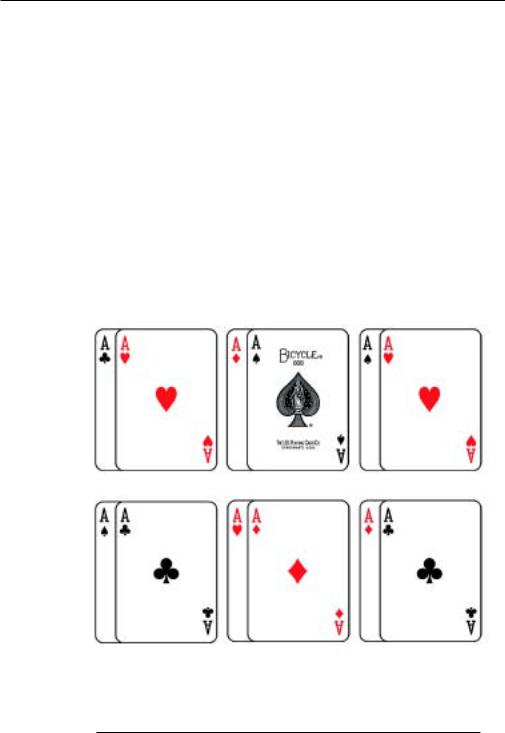
Odds in Texas Hold’em
To find the number of 2-card combinations possible from a 52-card deck, as demonstrated previously, we will use
Comb(52, 2):
(52 * 51) = 1,326 (1 * 2)
The number of pairs possible from any of the 13 ranks in a deck of cards can be calculated by Comb(4, 2):
(4 * 3) = 6 (1 * 2)
There are 6 possible pairs of Aces:
To find the odds of a pair of Aces in the hole, calculate the
25

2. The Basic Calculations
number of 2-card combinations that WILLNOT contain a pair of Aces:
Total Possible (1,326) – WILLs (6) = WILLNOTs (1,320)
WILLNOTs (1,320) : WILLs (6) 1,320 : 6
Reduce 1,320 / 6 : 6 / 6
220 : 1
Another way to find the probability of pocket rockets is to multiply the probability that the first card will be an Ace (4 / 52) by the probability that the second card will be an Ace (3 / 51):
524 * 513 = .0045249
To calculate the odds that you will find ANY pair in the pocket:
There are 6 possible pairs from each of 13 ranks in the deck, so there are 6 * 13 = 78 possible pairs in a deck.
Total Possibilities = 1,326
– WILLs = 78
WILLNOTs = 1,248
WILLNOTs (1,248) : WILLs (78) 1,248 : 78
Reduce 1,248 / 78 : 78 / 78
16 : 1
26

Odds in Texas Hold’em
Before the Flop
Before the Flop, what you want to know most is the odds or probability that the Flop will improve your hand.
The Flop is a set of 3 cards. To calculate the odds or probability that the Flop will make the desired improvement, you will need to know at least 2 of the following 3 values:
1.The total number of 3-card Flops possible from the deck, minus your 2 hole cards
2.The total number of 3-card combinations that WILL make the desired improvement
3.The total number of 3-card combinations that WILLNOT make the desired improvement.
With 2 cards in the hole there are 50 unseen cards. To find the total number of 3-card Flops possible from the rest of the deck, use Comb(50, 3):
(50 * 49 * 48) = 19,600 (1 * 2 * 3)
To find the number of 3-card combinations that WILL improve your hand depends on the hand.
To find the number of 3-card combinations that WILLNOT make the improvement, use Total Possible – WILLs = WILLNOTs.
Pocket Pair >>> Set or Full House
To find the odds of flopping a Set or a Full House with a Pair in the pocket, find the number of 2-card combinations pos-
27

2. The Basic Calculations
sible from the remaining unseen 50 cards minus the 2 cards that will make the Set — Comb(48, 2):
(48 * 47) = 1,128 (1 * 2)
Multiply this number (1,128) by the number of remaining cards that WILL make the Set (2) to find the number of possible 3-card Flops that will make the Set or a Full House:
1,128 * 2 = 2,256
There is a possibility that a Set could come on the Flop. This would also make a Full House with the Pair in the pocket.
From the 12 ranks that do not include the rank of the pocket pair, there are 48 different 3-card combinations that are Sets
— Comb(4, 3) * 12:
(4 * 3 * 2) * 12 = 48 (1 * 2 * 3)
In all, there are 2,256 + 48 = 2,304 possible 3-card Flops that will make a Set or Full House when holding a pocket Pair.
You now have all the numbers needed to calculate the odds of flopping a Set or a Full House:
Total Possibilities = 19,600
– WILLs = 2,304
WILLNOTs = 17,296
Odds of Flopping a Set or Boat with a Pocket Pair WILLNOTs : WILLs
28

Odds in Texas Hold’em
17,296 : 2,304 Reduce
17,296 / 2,304 : 2,304 / 2,304
7.5 : 1
Chapters 4 — Odds in Texas Hold’em and 6 — Odds in Omaha Hi-Lo — explain the odds of flopping Straight and Flush draws, Straights and Flushes, and more.
After the Flop
Once the Flop has hit the board, you have 5 of the 7 cards that will make your best and final hand. After the Flop and with 2 cards to come, regardless of the hand, any player still involved must know
1.The odds of improvement on the next card (the Turn)
2.The odds of improvement over the next two cards (the Turn and the River)
3.The odds of hitting certain Runner-Runner hands.
Odds of Improvement on the Turn
After the Flop, the calculation of the odds of improvement with the next card is straightforward. The only number that changes is the number of outs.
After the Flop and before the Turn, counting your 2 hole cards and the 3 Flop cards, there are 47 unseen cards.
29

2. The Basic Calculations
Open Ended Straight Draw >>> Straight
The odds that an open ended Straight draw will improve into a Straight with the Turn card are easily calculated.
Regardless of how the 4 cards making up the draw lie, there are 8 outs to make the Straight:
Total Possibilities = 47
– WILLs = 8
WILLNOTs = 39
Odds of Turning a Straight with an Open Ended Draw WILLNOTs : WILLs
39 : 8 Reduce
39 / 8 : 8 / 8
4.9 : 1
Odds of Improvement on Either/Both the Turn or the River
After the Flop and before the Turn card has been dealt, there are 47 unseen cards. When calculating the odds with 2 cards to come, one important number is the total number of possible 2-card combinations that can be made from the remaining unseen 47 cards — Comb(47, 2):
(47 * 46) = 1,081 (1 * 2)
With 2 cards to come there are 4 possibilities:
1. You will hit none of your outs on either card
30

Odds in Texas Hold’em
2.You will hit one of your outs on the Turn
3.You will hit one of your outs on the River
4.You will hit one of your outs on the Turn and another on the River.
Open Ended Straight Draw >>> Straight with 2 Cards to Come
The odds of completing an open-ended Straight draw with 2 draws to come are a lot better than with only one draw left. In the above example, the odds of making the Straight on the Turn are almost 5 : 1. As you can see below, the odds of making the Straight on EITHER or both the Turn or River are just over 2 : 1.
Of 47 unseen cards, 8 will make the straight and 39 will not:
8 * 39 = 312
312 2-card combinations will contain 1 and only 1 Straight card.
(8 * 7) = 28 (1 * 2)
28 2-card combinations will contain 2 Straight cards including the possibility of a Pair.
312 + 28 = 340 possible 2-card combinations that WILL make the Straight:
Total Possibilities = 1,081
– WILLs = 340
WILLNOTs = 741
31

2. The Basic Calculations
Odds of a Straight with Open Ended Draw and 2 Cards to Come WILLNOTs : WILLs
741 : 340 Reduce
741 / 340 : 340 / 340
2.18 : 1
Runner — Runner
After the Flop and with 2 cards to come, you will need help on both of them. No one card will do it.
Remember — runner-runners don’t complete very often and in most cases require extraordinary money odds to be played profitably.
To prove this point, let’s consider the odds:
♦To make the Straight with 2 cards to come, the odds are a little over 2 : 1
♦With only 1 card to come they are nearly 5 : 1
♦When runner-runner is required they are over 20 : 1 against.
Open Backdoor 3-Straight >>> Straight
With 3 connected cards above 2 and below K in rank, there are 3 sets of 2-card combinations that will make the Straight. For each of these 3 sets, there are 4 * 4 = 16 possible combinations. Therefore, there are a total of 3 * 16 = 48 2-card combinations that will make the Straight:
32
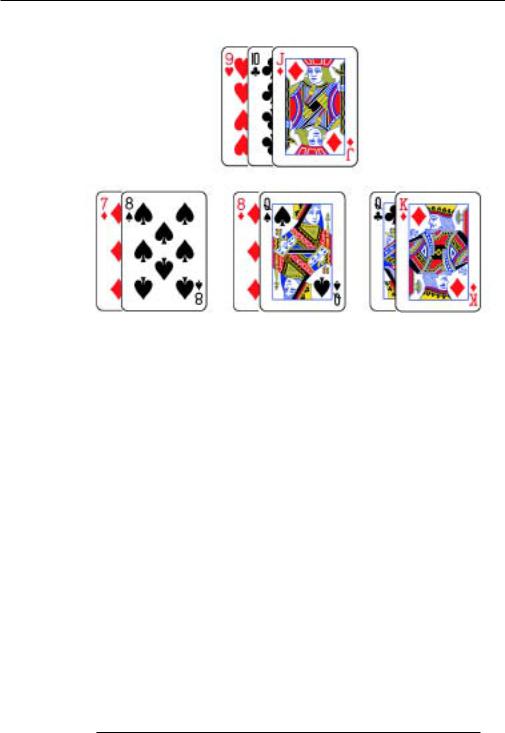
Odds in Texas Hold’em
Total Possibilities = 1,081
– WILLs = 48
WILLNOTs = 1,033
Odds of a Runner-Runner Straight WILLNOTs : WILLs
1,033 : 48 Reduce
1,033 / 48 : 48 / 48
21.52 : 1
Before the Last Card
With one card to come, the odds calculation for the various hands is straightforward. Here again, the only number that changes is the number of outs.
33

2. The Basic Calculations
After the Turn card has hit the board, there are 2 cards in your pocket, 4 on the board and 46 unseen cards.
Total Possibilities = 46
Total Possibilities – WILLs (Outs) = WILLNOTs
Odds = WILLNOTs : WILLs (Outs)
There are 8 cards (4 on each end) that will make the Straight:
Total Possibilities = 46
– WILLs = 8
WILLNOTs = 38
Odds of a Straight with an Open Ended Draw WILLNOTs : WILLs
38 : 8 Reduce
38 / 8 : 8 / 8
4.75 : 1
The odds of making the Straight on the River are slightly better than the odds of making the same Straight on the Turn, because there is one less card that WILLNOT make the Straight among the unseen cards.
Odds in Omaha Hi-Lo
A major difference between calculating the odds in Texas Hold’em and the odds in Omaha Hi-Lo is that many Hi-Lo hands have opportunities to win in two ways.
Another difference is with starting hands. A player is more
34

Odds in Omaha Hi-Lo
than five times as likely to see Aces in the hole in Omaha as he is in Hold’em.
Omaha Hi-Lo is one of the few games in poker where the absolute nut hand can wind up losing money. It is also a game where, given usually large pots, playing unidirectional hands (regardless of strength) can carry a much-reduced expectation over the same hand in non-split games.
In split games, the difference between scoop and not-scoop is dramatic. If 4 players each have $200 invested in an $800 Omaha Hi-Lo pot:
Scooper Earns $600 Profit
Low Half Earns $200 Profit
Quartered Low Earns $000 Profit
Starting Hands in Omaha Hi-Lo
A number that will prove useful throughout these calculations is the total number of possible 4-card combinations in a 52-card deck — Comb(52, 4):
(52 * 51 * 50 * 49) = 270,725 (1 * 2 * 3 * 4)
There are 270,725 different starting hands possible in Omaha.
The Odds of AA in the Hole in Omaha
The odds of getting a pair of Aces in the hole in Omaha HiLo underscores the dramatic difference between Hold’em (with 2 cards in the pocket) and Omaha Hi-Lo (with 4).
35
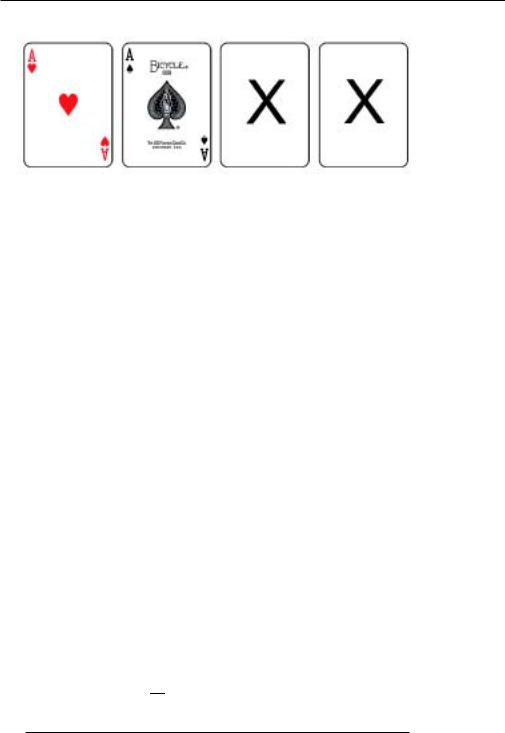
2. The Basic Calculations
The odds of pocket rockets in Hold’em are 220 : 1 and the odds of AAxx in the hole in Omaha Hi-Lo are 39 : 1, so you will see Aces in the hole more than 5 times as often in Omaha Hi-Lo as you will in Hold’em.
These odds can be calculated for exactly 2 Aces in the hole or for 2 or more Aces in the hole. The calculation that will serve you best is for exactly 2 Aces in the hole, because in Omaha, having 3 or more cards of the same rank in the hole is NOT a good thing. Omaha is one of the very few places in all of poker where a hand containing 4 hidden Aces is a huge disappointment.
Start with 270,725 — the total possible 4-card combinations in a deck of 52 cards.
Find the number of 2-card combinations that contain a pair of Aces — Comb(4, 2):
(4 * 3) = 6 (1 * 2)
The last number in this series is the number of 2-card combinations that contain no Aces — Comb(48, 2):
(48 * 47) = 1,128 (1 * 2)
36

Odds in Omaha Hi-Lo
To find the total number of 4-card combinations that contain exactly 2 Aces, multiply the number of 2-card combinations that WILL contain 2 Aces (6) by the number of 2-card combinations that WILLNOT contain any Aces (1,128):
6 * 1,128 = 6,768
The probability of 2 and only 2 Aces in the pocket in Omaha Hi-Lo expressed as a percentage is:
WILLs |
* 100 = Probability as % |
|
Total Possibilities |
||
|
270,7256.768 * 100 = 2.5%
To find the odds of a pair of Aces in the hole in Omaha Hi-Lo:
Total Possibilities = 270,725
– WILLs = 6,768
WILLNOTs = 263,957
WILLNOTs (263,957) : WILLs (6,768) 263,957 : 6,768
Reduce
263,957 / 6,768 : 6,768 / 6,768
39 : 1
Before the Flop
The total number of possible different 3-card Flops will be used throughout these calculations. With 4 hole cards, to determine the total possible 3-card Flops from the remaining 48 unseen cards — Comb(48, 3):
37

2. The Basic Calculations
(48 * 47 * 46) = 17,296 (1 * 2 * 3)
Another number that will be useful in these calculations is the number of 2-card combinations possible from the remaining unseen 48 cards — Comb(48,2):
(48 * 47) = 1,128 (1 * 2)
AA2X >>> Nut Low or Aces Full
With a premium starting hand and 2-way possibilities, you have excellent odds of making a very good hand in either or both directions.
To flop a Nut Low with this hand, the board must contain 3 unpaired cards ranked 3 through 8. There are 6 ranks of 4 suits, making Comb(24, 2) 2-card combinations:
(24 * 23) = 276 (1 * 2)
Minus 36 possible pairs among these ranks, there are 276 – 36 = 240 2-card combinations that will flop a Nut Low draw. Multiply this by all of the remaining cards ranked 3 through 8 that are not represented by the first 2 cards of the Flop (16), to produce the number of 3-card combinations that will make a Nut Low to this hand:
240 * 16 = 3,840
To flop Aces Full the board must contain an Ace and any pair. With this hand there are 66 unseen pairs ranked 3 through K, plus 1 pair of Aces and 3 pairs of Deuces, for a
38

Odds in Omaha Hi-Lo
total of 70 possible pairs that might appear on the board. Multiply this by the number of unseen Aces (2), to produce the number of possible 3-card Flops that will make Aces Full or better to this hand:
70 * 2 = 140
This calculation includes the possibility of flopping a pair of Aces to produce QUADS.
There are 3,840 + 140 = 3,980 possible 3-card Flops that will make a Nut Low hand or Aces Full or better to this hand. The odds of this Flop are:
Total Possibilities = 17,296
– WILLs = 3,980
WILLNOTs = 13,316
Odds of Flopping a Nut Low or Aces Full WILLNOTs : WILLs
13,316 : 3,980 Reduce
13,316 / 3,980 : 3,980 / 3,980
3.3 : 1
After the Flop
Once the Flop has hit the board, you have 7 of the 9 cards that will make your best and final hand for both low and high. Money expectations aside, as a general rule, only continue to invest in the hand with the nuts or a reasonable draw to the nuts in either direction, preferably both. If you don’t have them, the nuts that is, there are many chances that at least one of your opponents does.
39

2. The Basic Calculations
After the Flop and with 2 cards to come, regardless of the hand, any player still involved must know:
1.The odds of improvement on the next card (the Turn)
2.The odds of improvement over the next two cards (the Turn and the River)
3.The odds of hitting certain Runner-Runner hands.
Odds of Improvement on the Turn
With the Turn card to come, the odds calculation for the various hands is straightforward. The only number that changes is the number of outs.
After the Flop and before the Turn, counting your 4 hole cards, there are 45 unseen cards.
Low Draw & Flush Draw >>> Low or Flush
There are 16 cards that will complete the Low, plus 9 cards that will make the Flush, minus 4 cards that are counted among those that will make the Low — 16 + 9 – 4 = 21:
Total Possibilities = 45
– WILLs = 21
WILLNOTs = 24
Odds of Turning a Low or a Flush WILLNOTs : WILLs
24 : 21 Reduce
24 / 21 : 21 / 21
1.1 : 1
40

Odds in Omaha Hi-Lo
Odds With 2 Cards to Come
With 2 cards to come there are 4 possibilities:
1.You will hit none of your outs on either card
2.You will hit one of your outs on the Turn
3.You will hit one of your outs on the River
4.You will hit one of your outs on the Turn and another on the River.
When calculating the odds with 2 cards to come, one important number is the total number of possible 2-card combinations that can be made from the remaining unseen 45 cards
— Comb(45, 2):
(45 * 44) = 990 (1 * 2)
To find the WILLs, add the number of possible 2-card combinations that will contain 1 and only 1 of the available outs to the number of 2-card combinations that will contain 2 out cards.
Low Draw >>> Low with 2 Cards to Come
With a Low draw, 16 of the unseen 45 cards will make a Low. There are also 6 cards among the 45 that will counterfeit one of the low cards in the hole. Of the 45 unseen cards, there are 16 that will make the Low and 23 that can combine with one of these 16 to make the Low without counterfeiting one of the low cards in the hole.
41

2. The Basic Calculations
Therefore, 16 * 23 = 368 is the number of 2-card combinations, one card of which will make the Low.
Comb(16, 2) is the number of 2-card combinations that contain 2 cards that will make the Low, including pairs:
(16 * 15) = 120 (1 * 2)
120 2-card combinations will contain 2 low cards and still complete the Low without counterfeiting either of the low cards in the hole.
368 + 120 = 488 possible 2-card combinations that WILL make the Low:
Total Possibilities = 990
– WILLs = 488
WILLNOTs = 502
Odds of a Low with 2 Cards to Come WILLNOTs : WILLs
502 : 488 Reduce
502 / 488 : 488 / 488
1.03 : 1
WILLs |
* 100 = Probability as % |
|
Total Possibilities |
||
|
488990 * 100 = 49%
42

Odds in Omaha Hi-Lo
Odds of Runner – Runner
For runner-runner analysis, one number we need is the total possible 2-card combinations from the remaining 45 unseen cards:
(45 * 44) = 990 (1 * 2)
Back Door Low Draw >>> Runner-Runner Low
When playing Omaha Hi-Lo, it is often of great interest to know the odds of making a backdoor Low.
With 2 low cards in the hole and 1 usable low card on the board, even if the board low card is paired, there are 20 cards of 5 ranks, any unpaired 2 of which will make the runner Low — Comb(20, 2), minus the 30 pairs possible among the cards from these 5 ranks. Therefore:
(20 * 19) = 190 (1 * 2)
190 – 30 = 160 possible 2-card combinations WILL make a runner-runner Low:
Total Possibilities = 990
– WILLs = 160
WILLNOTs = 830
Odds of a Runner-Runner Low
WILLNOTs : WILLs
830 : 160
Reduce
43

2. The Basic Calculations
830 / 160 : 160 / 160
5.2 : 1
Before the Last Card
With one card to come, the odds calculation for the various hands is straightforward. The only number that changes is the number of outs.
After the Turn card has hit the board, there are 4 cards in your pocket, 4 on the board and 44 unseen cards.
Low Draw >>> Low
With a Low draw, there are 16 cards from 4 ranks that can come on the River to make the Low:
Total Possibilities = 44
– WILLs = 16
WILLNOTs = 28
Odds of Making a Low WILLNOTs : WILLs
28 : 16 Reduce
28 / 16 : 16 / 16
1.75 : 1
WILLs |
* 100 = Probability as % |
|
Total Possibilities |
||
|
1644 * 100 = 36%
44
